Czichos H., Saito T., Smith L.E. (Eds.) Handbook of Metrology and Testing
Подождите немного. Документ загружается.


528 Part C Materials Properties Measurement
ials. Polar materials, on the other hand, have permanent
molecular dipoles which may exhibit a number of dif-
ferent relaxation processes, each having a characteristic
strength measured by Δε
r
, and a characteristic relax-
ation frequency f
r
. In the simplest case with a single
relaxation time τ
r
the dielectric relaxation function may
be described by Debye’s model [9.66],shownby(9.69).
Here ε
u
is the dielectric constant at high frequencies,
which does not contain a permanent dipole contribution
(ε
r
=ε
u
when f f
r
,Fig.9.58)
ε
∗
ε
0
=ε
u
+
Δε
r
1 +iωτ
r
. (9.69)
Cooperative distortional polarization, local rotational
polarization and interfacial polarization are the most
commonly observed relaxation processes. In a compos-
ite material, many or all of these processes may be
present and give rise to a very complex relaxation be-
havior, which can be modeled as a superposition of
several relaxations. The Havriliak–Negami (HN) relax-
ation function, defined below, has often been found to
provide a good phenomenological description of dielec-
tric relaxation data in molecular liquids, solids and glass
formers [9.81,82]
ε
∗
ε
0
=
k
ε
u
+
Δε
r
[1+(iωτ
r
)
α
]
γ
,
k =1, 2, 3,... (9.70)
The parameters α and γ describe the extent of symmet-
ric (α) and asymmetric (γ ) broadening of the complex
dielectric function, where α and γ are (0 <α≤1and
0 <αγ ≤1). Equation (9.70) reduces to the well-known
Debye expression when α =γ =1. While the HN equa-
tion is often referred to as an empirical relaxation
function, recent modeling has linked the parameters α
and γ to the degree of intermittency in molecular move-
ment and long-lived spatial fluctuations in local material
properties (dynamic heterogeneity)[9.83], which gives
some insight into the meaning of the fitted parameters.
In this view, the exponent α is related to the tempo-
ral intermittency of molecular displacements while γ
corresponds to long-lived dynamic heterogeneities (or
dynamic clusters). It is beyond the scope of this chapter
to explain the theory of these processes and the reader
is advised to consult references [9.84–87].
Regardless of the particular molecular mechanism
of the dielectric relaxation, the phenomenological de-
pendence of ε
∗
r
on frequency, as shown in Fig. 9.58, can
be used as a guide to select an appropriate measurement
method, and then be applied to describe and analyze the
dielectric properties of most dielectric materials.
Z
S
R
S
L
R
R
R
C
S
C
S
J
E
'
Fig. 9.59 Equivalent electrical circuit of a dielectric ma-
terial
According to Fig. 9.58, the frequency spectrum can
be divided into several regions, each corresponding to
a characteristic dielectric response.
1. At low frequencies, well below f
r
, dipoles easily re-
spond and align with the applied alternating E-field
without a time lag. The dielectric loss is negligi-
bly small and the polarization as measured by ε
r
can achieve the maximum value, which depends on
the statistical distribution of thermally induced mo-
lecular orientations and the amplitude of the applied
field. At higher fields, polarization saturation may
occur, where all the dipoles are aligned. The E-field
induced polarization dominates over the thermal ef-
fects, giving rise to a nonlinear dielectric response.
2. At frequencies close to f
r
, the molecular dipoles are
too slow to reorient in phase with the alternating
electric field. They lag behind and their contribution
to ε
r
is smaller than that at low frequencies. This
time lag or phase difference between E and P gives
rise to the dielectric loss which peaks at f
r
.
3. At frequencies above f
r
the particular molecular
dipoles cannot follow the electric field and do not
contribute to ε
r
and ε
r
,andε
r
=ε
u
.
It is important to note that the relaxation process
always leads to a decrease of ε
r
with increasing fre-
quency. Dipolar relaxation can be adequately described
by an electrical equivalent circuit consisting of a ca-
pacitance C
s
connected in parallel with resistance R
s
which is illustrated in Fig. 9.59. Both, C
s
and R
s
can be
experimentally measured and related to the material’s
dielectric properties ε
r
and ε
r
.
Resonant Transitions
The rapid oscillations of ε
r
shown in Fig. 9.58 at fre-
quencies above f
r
indicate a resonance. Similarly to
relaxation, the resonance transitions are associated with
the dielectric loss peak. However, the distinguished fea-
Part C 9.5
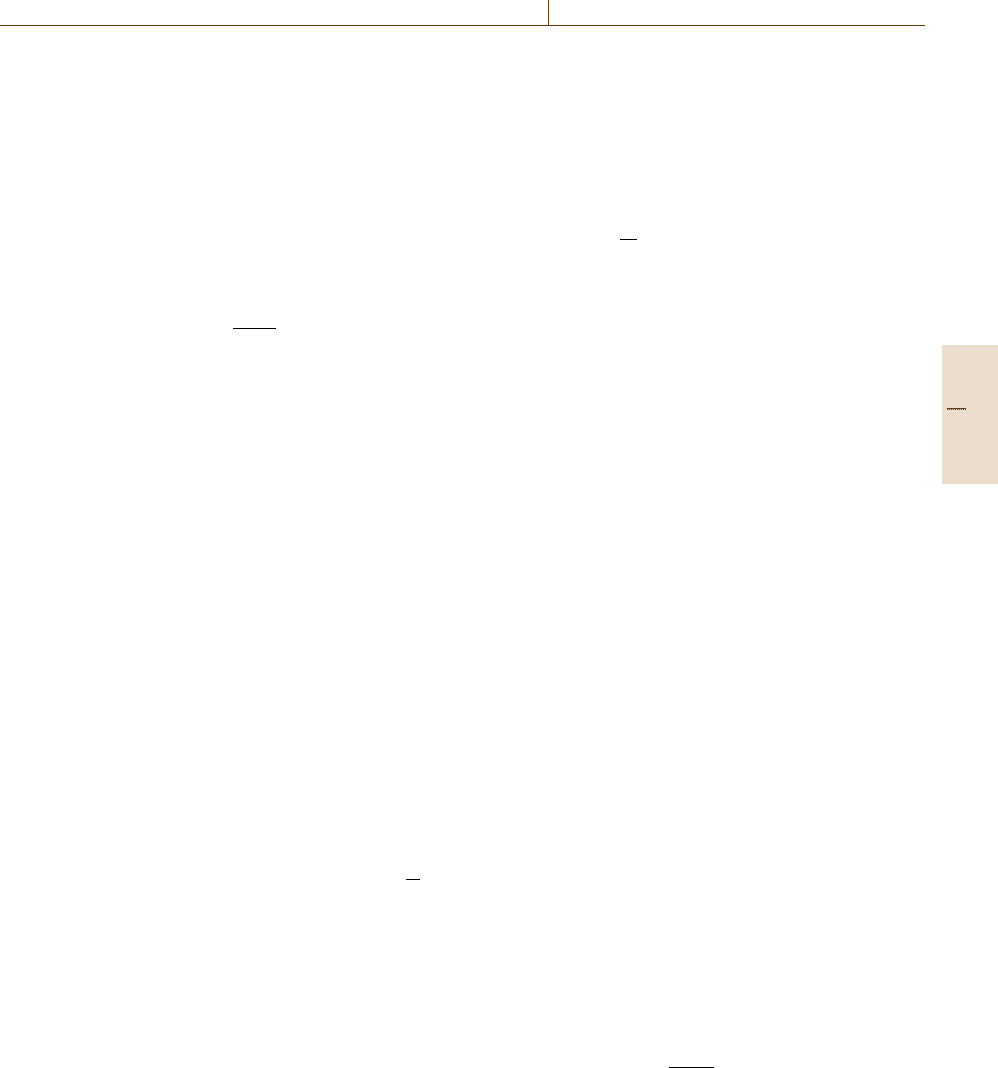
Electrical Properties 9.5 Measurement of Dielectric Materials Properties 529
ture of a resonance transition is a singular behavior of ε
r
at the resonant frequency. From the dielectric metrology
viewpoint, the most important resonances are the series
resonance and the cavity resonance. These transitions
are typically observed in the radio-frequency range and
at microwave frequencies, respectively.
Series Inductance–Capacitance Circuit
Resonance
Every electrical circuit consists of interconnecting leads
that introduce finite residual inductance L
R
. Therefore,
when measuring a capacitance C
s
there will be a cer-
tain frequency f
LC
=1/(2π
√
L
R
C
s
) at which a series
resonance occurs. The equivalent electrical circuit for
the series resonance consists of C
s
in series with L
R
.
The residual resistance R
R
is due to finite conductivity
of the interconnects (Fig. 9.59). Since at f
LC
the en-
ergy is concentrated in the magnetic field (or current)
of the inductive component L
R
rather than in the elec-
tric field in C
s
, these resonance conditions generally are
not useful in measurement of the dielectric permittiv-
ity. The phenomenon is a common source of systematic
errors in dielectric metrology unless the inductance is
known or introduced purposely [9.88] to determine the
capacitance from the resonant frequency. The character-
istic feature of the series resonance is a rapid decrease
in the measured complex impedance which reaches the
value of R
R
when the frequency approaches f
LC
. The
drop in the impedance is associated with an abrupt
change of phase angle from −φ to φ. The C
s
value ap-
pears very large near f
LC
when L
R
is neglected in the
equivalent circuit (Fig. 9.59), and consequently, it can
be incorrectly interpreted as an apparent increase in the
dielectric constant (Fig. 9.58).
Dielectric Resonance
When the dimensions (l) of the dielectric specimen are
comparable with the guided wavelength λ
g
= λ
0
/
ε
r
a superposition of the transmitted and reflected waves
leads to a standing wave called cavity or dielectric res-
onance. At the resonant frequency, the electromagnetic
energy is concentrated in the electric field inside the di-
electric. Therefore the measurement techniques that are
based on the dielectric resonators are the most accurate
methods for determining the dielectric permittivity of
low loss materials.
Infrared and Optical Transitions
Interaction of electromagnetic radiation with mater-
ials at frequencies of about 10
12
Hz and above gives
rise to quantized resonant transitions between the elec-
tronic, vibrational and rotational molecular energy
states. These transitions are responsible for a singular
behavior of the dielectric permitivity and the corre-
sponding absorption, which can be observed by using
appropriate quantum spectroscopy techniques. These
quantum spectroscopies form a large part of modern
chemistry and physics. At optical frequencies the ma-
terials dielectric properties are described by complex
optical indices, n
∗
=
√
ε
∗
, rather than permittivity.
9.5.2 Measurement of Permittivity
Techniques for complex permittivity measurement may
be subdivided into two general categories [9.75].
1. The frequency range, typically below 1 GHz, over
which the dielectric specimen maybe treated as
a circuit of lumped parameter components. Be-
cause the mathematical manipulations are relatively
simple, the lumped parameter circuit approximate
equations can always be used when they yield the
required accuracy over sufficiently broad frequency
range.
2. The high frequency range where the wavelength
of the electric field is comparable to the phys-
ical dimensions of the dielectric specimen and,
as a consequence, it is often referred as a dis-
tributed parameter system. Distributed parameter
analysis based on the exact relations obtained from
Maxwell’s equations, is necessary when the effec-
tive values of circuit elements change rapidly with
frequency, or when the highest accuracy is needed.
In the low frequency range, where the wave propa-
gation effects can be neglected, the equivalent complex
impedance Z
s
of the relaxation circuit shown in Fig. 9.59
can be measured to determine the complex capacitance
C
s
and then the material’s relative complex permittiv-
ity ε
∗
r
. In the following discussion complex impedance
Z
s
= Z
s
−iZ
s
is considered to be a constant propor-
tionality of sinusoidal voltage and current. Parameters
shown in bold face indicate complex (vector) quantities.
When a capacitor is filled with a dielectric mater-
ial (Sect. 9.1.6) the resulting capacitance is C
s
and the
dielectric permittivity is defined by (9.71)
ε
∗
r
(ω) =ε
r
(ω)−iε
r
(ω) =
C
s
(ω)
C
0
, (9.71)
where C
0
is the capacitance of the empty cell and ω is
the angular frequency (ω =2π f ).
If the sinusoidal electric field E(ω) = E
0
exp(iωt)is
applied to C
s
then the dielectric permittivity can be de-
Part C 9.5
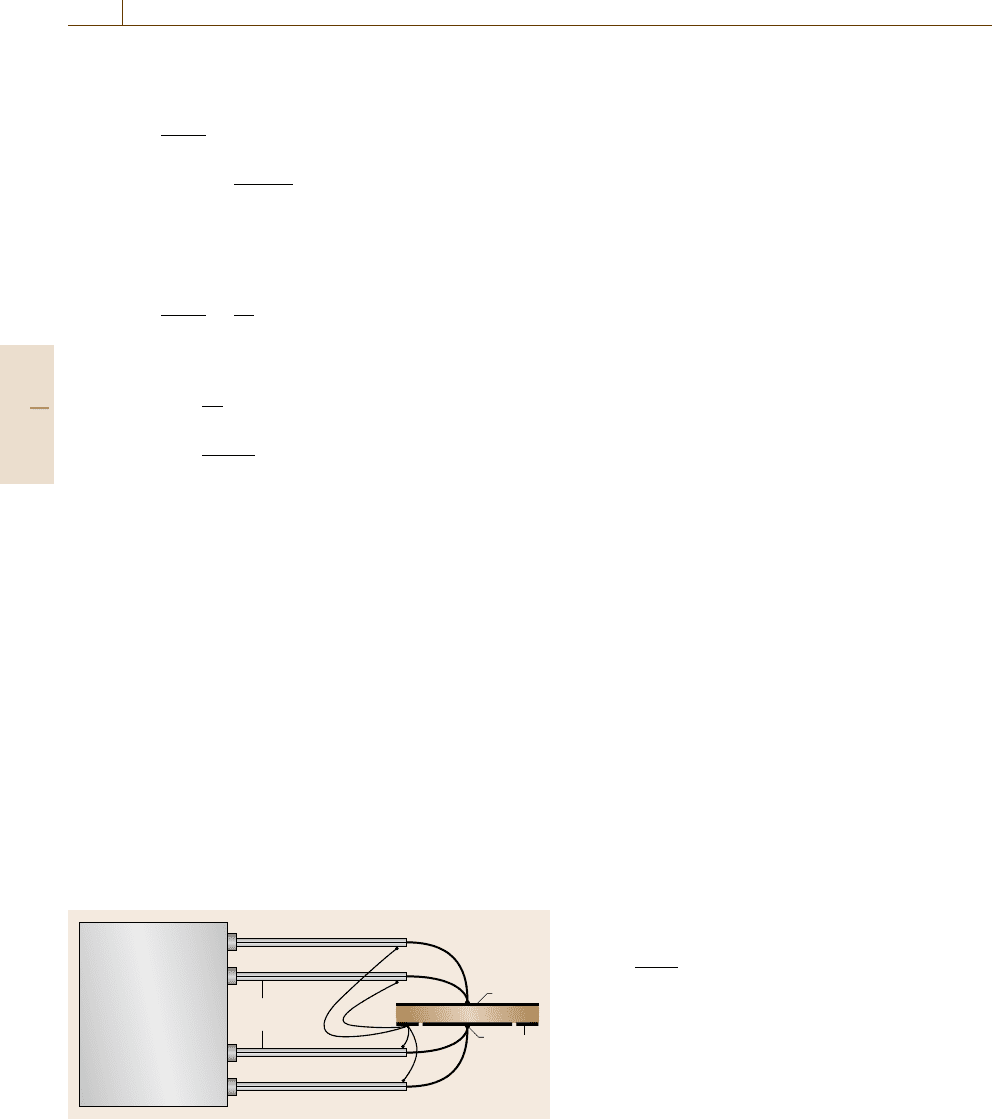
530 Part C Materials Properties Measurement
termined by measuring the complex impedance Z
s
of
the circuit.
1
Z
s
(ω)
=iωC
s
, (9.72)
ε
∗
r
(ω) =
1
iωZ
s
C
0
, (9.73)
Consistent with the electrical equivalent circuit of the
real capacitance C
s
in parallel with a resistance R
s
the
impedance is given by
1
Z
s
(ω)
=
1
R
s
+iωC
s
(9.74)
and the direct expressions for ε
r
and ε
r
are
ε
r
=
C
s
C
0
, (9.75)
ε
r
=
1
ωR
s
C
0
. (9.76)
The capacitance of the empty cell C
0
(cell constant)
is typically determined from the specimen geometry or
measurements of standard materials with known dielec-
tric permittivity. Commercially available dielectric test
fixtures have the cell constant and error correction for-
mulas provided by their manufacturers [9.89,90].
Impedance Measurement
Using a Four-Terminal Method
In the frequency range of up to about 10
8
Hz, a four
terminal (4T) impedance analyzer can be employed
to measure complex impedance of the capacitance C
s
and then the permittivity can be calculated from (9.74–
9.76). The 4T methodology refers to the direct phase
sensitive measurement of the sample’s current and volt-
age. Systems combining Fourier correlation analysis
with dielectric converters and impedance analysis have
recently become commercially available [9.79]. The
Terminals
Terminals
“Hi”
current
“Hi”
voltage
“Lo”
current
“Lo”
voltage
Coaxial
cables
S
S
SS
L
H
G
ε*
Impedance
analyzer
Fig. 9.60 A 3T cell to an 4T impedance analyzer. H and L are the
high and low potential electrodes respectively; G is the guard elec-
trode; S are the return current loops of coaxial shield connections
recently developed dielectric instrumentation incorpo-
rates into one device a digital synthesizer-generator,
sine wave correlators and phase sensitive detectors,
capable of automatic impedance measurements from
10
−2
to 10
13
Ω. The broad impedance range also allows
a wide capacitance measurement range with resolu-
tion approaching 10
−15
F. The instrumentation should
be calibrated against appropriate impedance standards
using methods and procedures recommended by their
manufacturers.
The dielectric samples typically utilize a parallel-
plate or cylindrical capacitor geometry [9.75,91]having
capacitances of about 10 pF to several hundred pF. The
standard measurement procedures [9.91] recommend
a three-terminal (3T) cell configuration with a guard
electrode (G), which minimizes the effect of the fring-
ing and stray electric fields on the measurements. The
optimal method for connecting a 3T circular cell to a 4T
impedance analyzer is shown in Fig. 9.60.
The high current on voltage terminals should be
connected via coaxial cables directly to the unguarded
electrode H, while the low current and voltage should
be connected to the electrode that is surrounded by the
guard electrode. Note that the return current loop of
coaxial shields connections S should be short and con-
nected to G at a single common point. The return current
loop S is absolutely necessary for accurate impedance
measurements, especially above 1 MHz. In a two termi-
nal configuration (2T) without the guard electrode, the
connections S should be simply grounded together.
The dielectric constant, dielectric loss and the relax-
ation frequency are temperature dependent. Therefore,
it is essential to measure the specimen temperature and
to keep it constant (isothermal conditions) during the
measurements.
Impedance Measurements
Using Coaxial Line Reflectometry
In the 4T configuration the residual inductance L
R
of in-
terconnecting cables contributesto the circuit impedance
creating conditions for the series resonance at f
LC
≈
1/(2π
L
R
C
s
), which limits the usable frequency range.
Typically, the series resonance occurs above about
30 MHz. Impedance at higher frequencies may be deter-
mined from the reflection coefficient using microwave
techniques with precision transmission lines. In these
techniques the reference plane can be set up right at
the specimen section which largely eliminates propaga-
tion delay due to L
R
. When a dielectric specimen of
impedance Z
s
terminates a transmission line that has
a known characteristic impedance Z
0
and known wave
Part C 9.5
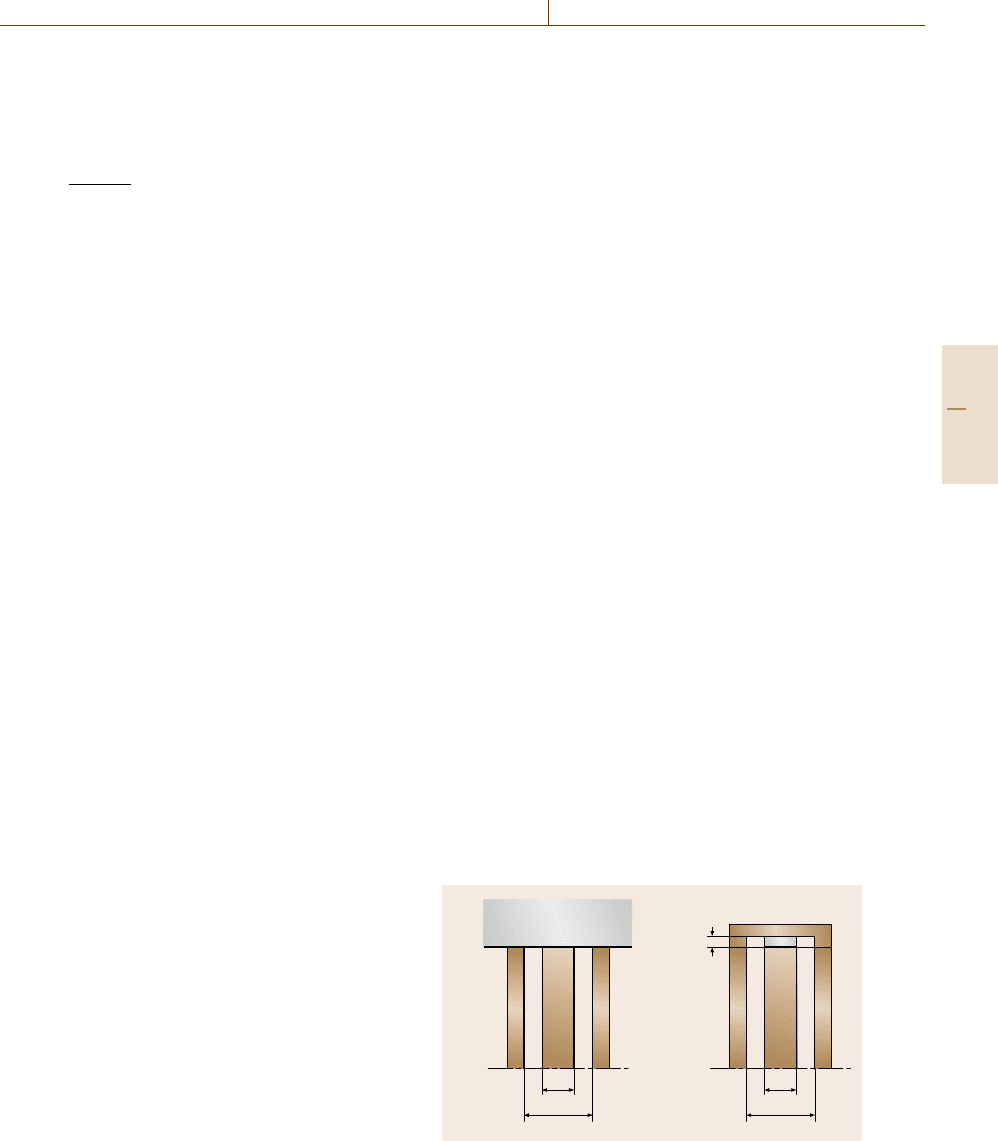
Electrical Properties 9.5 Measurement of Dielectric Materials Properties 531
propagation characteristic, the impedance mismatch be-
tween the line and the specimen results in reflection of
the incoming wave. The relation between Z
s
and com-
plex reflection coefficient Γ isgivenby(9.77)[9.92,93]
Γ =
Z
s
−Z
0
Z
s
+Z
0
. (9.77)
It follows from (9.77) that when the line is terminated
with a short (Z
short
= 0) then Γ =−1. For an open
termination (Z
open
=∞) Γ = 1, while in the case of
a matched load, when Z
s
= Z
0
, Γ = 0, which results in
no reflection. These three terminations, i. e. short, load
and open, are used as calibration standards for setting-up
the reference plane and proper measurement conditions
of the reflection coefficient |Γ | and the phase angle φ.
Many coaxial line configurations are available in the
RF and microwave ranges, each designed for a specific
purpose and application. The frequency range is limited
by the excitation of the first circular waveguide propa-
gation mode in the coaxial structure [9.92]. Decreasing
the diameter of the outer and inner conductors increases
the highest usable frequency. The following is a brief re-
view of coaxial line configurations, having Z
0
of 50 Ω,
most commonly used for microwave testing and mea-
surements [9.94].
Precision APC-7 mm Configuration
The APC-7 (Amphenol Precision Connector-7 mm) uti-
lizes air as a dielectric medium between the inner
and outer conductors. It offers the lowest reflection
coefficient and most repeatable measurement from
DC to 18 GHz, and is the preferred configuration for
the most demanding applications, notably metrology
and calibration. The diameter of the inner conductor
d = 3.02 mm and the diameter of the outer conductor
D =7.00 mm (Fig. 9.61) determines the characteristic
impedance value of 50 Ω [9.92].
Precision APC-3.5 mm Configuration
The 3.5 mm configuration also utilizes air as a dielectric
medium between the inner and outer conductors. It is
mode free up to 34 GHz.
Precision-2.4 mm Configuration
The 2.4 mm coaxial configuration was developed by
Hewlett Packard and Amphenol for use up to 50 GHz. It
can mate with the APC 3.5 mm connector through ap-
propriate adapters. The 2.4 mm coaxial line is offered
in three quality grades: general purpose, instrument, and
metrology. The general purpose grade is intended for
economy use on components and cables. Instrument
grade is best suited for measurement applications where
repeatability and long life are primary considerations.
Metrology grade is best suited for calibration applica-
tions where the highest performance and repeatability
are required.
1.85 mm Coaxial Configuration
The 1.85 mm configuration was developed in the mid-
1980s by Hewlett Packard, now Agilent Technologies,
for mode-free performance to about 65 GHz. HP of-
fered their design to the public domain in 1988 to
encourage standardization of this connector types. Nev-
ertheless, few devices and instrumentation are available
today from various manufacturers, mostly for research
work. The 1.85 mm connector mates with the 2.4mm
connector.
1.0 mm Coaxial Configuration
Designed to support transmission all the way up to
110 GHz, approaching optical frequencies. This 1.0mm
coaxial configuration, including the matching adapters
and connectors, is a significant achievement in precision
microwave component manufacturing.
Coaxial Test Fixtures
There is a large family of coaxial test fixtures designed
for dielectric measurements.
Open-ended coaxial test fixtures (Fig. 9.61a) are
widely used for characterizing thick solid materials and
liquids [9.95], and are commercially available (Agilent,
Novocontrol Dielectric Probes) [9.96]. The measure-
ments are conveniently performed by contacting one flat
surface of the specimen or by immersing the probe in
the liquid sample.
Short-terminated probes (Fig. 9.61b) are better
suited for thin film specimens. Dielectric materials of
a) b)
a
b
a
b
t
Fig. 9.61 (a) Open-ended, and (b) short terminated coaxial
test fixture with a film specimen of thickness t
Part C 9.5
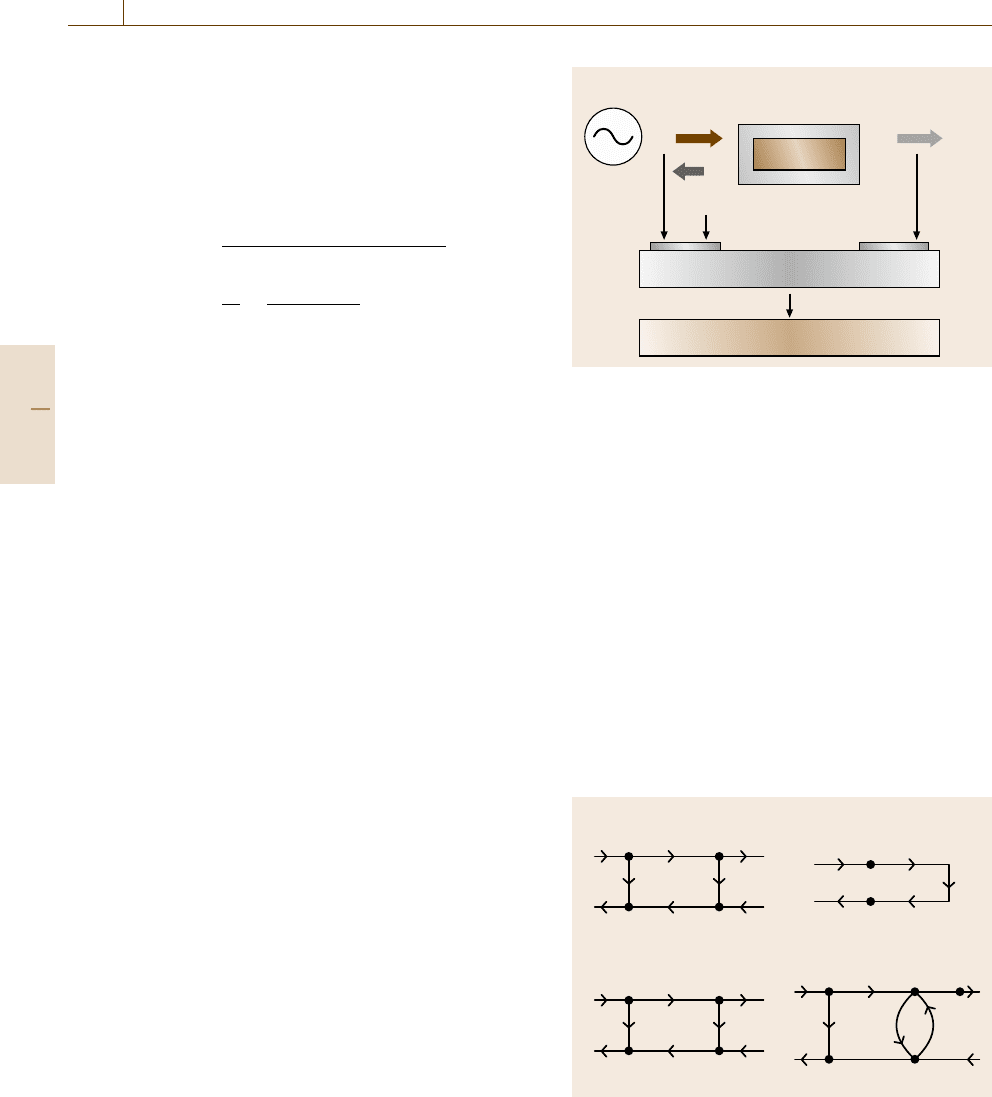
532 Part C Materials Properties Measurement
precisely known permittivity (air, water) are often used
as a reference for correcting systematic errors in mea-
suring |Γ | and the phase angle φ, that are due to
differences between the measurement and the calibra-
tion configurations. If the relaxation circuit satisfies the
lumped parameters, then ε
r
and ε
r
can be obtained by
combining (9.73)and(9.77)[9.97,98]
ε
r
=
−2
|
Γ
|
sin φ
ωZ
0
C
0
1+2Γ cos φ +
|
Γ
|
2
, (9.78)
tan δ =
ε
r
ε
r
=
1−
|
Γ
|
2
−2
|
Γ
|
sin φ
. (9.79)
In practice, the conventional lumped parameter formu-
las (9.78, 9.79) and the corresponding test procedures
are accurate up to a frequency at which the impedance
of the specimen decreases to about one tenth (0.1) of the
characteristic impedance of the coaxial line. Since the
standard characteristic impedance of coaxial configura-
tion listed above is 50 Ω, the lowest usable impedance
value of lumped-parameter circuits is about 5 Ω, hence,
f
max
≈1/(10πC
s
)[9.99]. Depending on the specimen
permittivity and thickness, this upper frequency limit in
the APC-7 configuration is typically below 5 GHz. At
frequencies f > f
max
, wave propagation causes a spa-
tial distribution of the electric field inside the specimen
section which can no longer be treated as a lumped
capacitance and has to be analyzed as a microwave net-
work.
9.5.3 Measurement of Permittivity
Using Microwave Network Analysis
Microwave network analyzer terminology describes
measurements of the incident, reflected, and transmit-
ted electromagnetic waves [9.100]. The reflected wave
can be, for example, measured at the Port 1, and the
transmitted wave is measured at Port 2 (Fig. 9.62).
If the amplitude and phase of these waves are
known, then it is possible to quantify the reflection
and transmission characteristics of a material under test
(MUT) with its dielectric permittivity and the dimen-
sions of the test fixture. The reflection and transmission
parameters can be expressed as vector (magnitude and
phase), scalar (magnitude only), or phase-only quanti-
ties. In this notation, impedance Z, reflection coefficient
Γ and complex wave amplitudes a
i
, b
i
are vectors.
Network characterization at low frequencies is usually
based on measurement of complex voltage and current
at the input or output ports (terminals) of a device.
Since it is difficult to measure total current or voltage
at high frequencies, complex scattering parameters, S
11
,
Source
Incident
Test fixture
Transmitted
Receiver/detector
Processor
Port 1
Reflected
Port 2
MUT
a
1
b
1
b
2
Fig. 9.62 Block diagram of a network analyzer
S
12
, S
21
and S
22
are generally measured instead [9.101,
102]. Measurements relative to the incident wave al-
low normalization and quantification the reflection and
transmission measurements to obtain values that are in-
dependent of both, absolute power and variations in
source power versus frequency. The scattering param-
eters (S-parameters) are defined by (9.80)[9.101]
b
1
= S
11
a
1
+S
12
a
2
,
b
2
= S
21
a
1
+S
22
a
2
. (9.80)
A general signal flow graph of a two-port network
with the corresponding scattering parameters is shown
in Fig. 9.63a. Here a
1
and a
2
are the complex ampli-
tudes of the waves entering the network, while b
1
and
b
2
are complex amplitudes of the outgoing waves.
b)
c) d)
a
1
b
2
S
21
b
1
a
1
b
1
a
2
a
1
b
2
b
1
a
2
a
1
b
2
b
1
a
2
S
12
S
11
S
22
1+Γ
1+Γ
(1 + Γ )
1–Γ
1–Γ
ΓΓΓ
Γ
–Γτ –Γτ
a)
Fig. 9.63a–d Scattering parameters signal flow diagrams:
(a) two-port network, (b) load termination, (c) shunt admit-
tance, (d) transmission line partially filled with a dielectric
specimen of a transmission coefficient τ
Part C 9.5
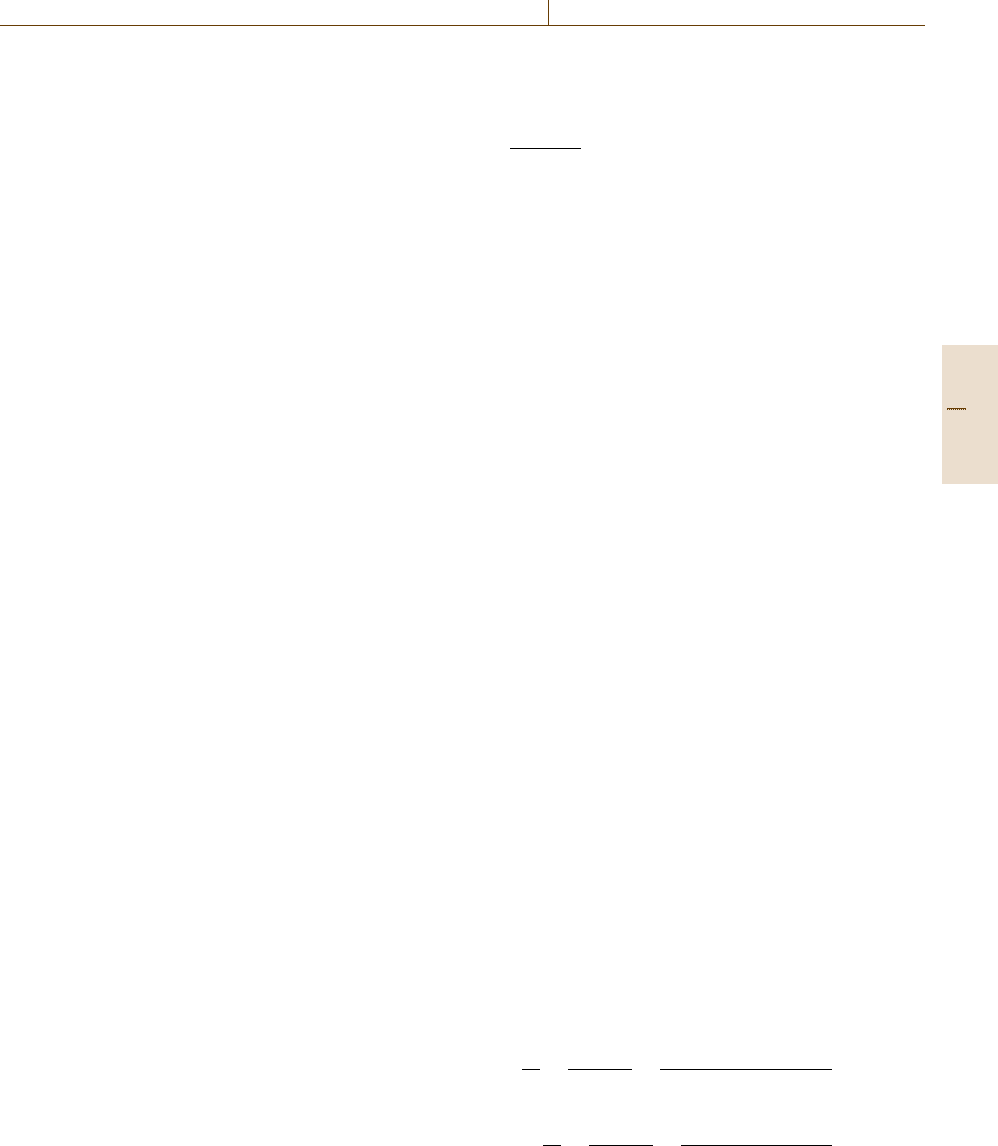
Electrical Properties 9.5 Measurement of Dielectric Materials Properties 533
The number of S-parameters for a given device is
equal to the square of the number of ports. For example,
a two-Port device has four S-parameters. The number-
ing convention for S-parameters is that the first number
following the S is the Port at which energy emerges,
and the second number is the port at which energy en-
ters. S
21
is a measure of power emerging from Port 2
as a result of applying an RF stimulus to Port 1. Same
numbers (e.g. S
11
, S
22
) indicate a reflection measure-
ment. The measured S-parameters of multiple devices
can be cascaded to predict the performance of more
complex networks. Figure 9.63b shows a termination or
load with a reflection coefficient Γ . Since there is no
transmitted wave to Port 2, b
2
= 0, Γ = b
1
/a
1
= S
11
.
Figure 9.63c is a shunt discontinuity, such as the junc-
tion of two lines or impedance mismatch, for which
S
11
= S
22
=Γ , while S
12
= S
21
=1 +Γ [9.101]. Fig-
ure 9.63d shows the flow diagram for a transmission
line, which is partially filled with a dielectric material
of finite length l [9.103]. This network has a practical
application in the dielectric measurements.
Network Calculations by Using Scattering
Parameters and Signal-Flow Graphs
Scattering parameters are convenient in many calcula-
tions of microwave networks and they form a natural set
for use with signal-flow graphs. In S-parameter signal-
flow graphs, each port is represented by two nodes a
k
and b
k
(Fig. 9.63). Node a
k
represents a complex wave
entering the network at port k, while node b
k
repre-
sents a complex wave leaving the network at port k.
The complex scattering parameters are represented by
multipliers on directed branches connecting the nodes
within the network. The transfer function between any
two nodes in the network can be determined by using
topological flow graph rules [9.101, 104]. The Mason’s
nontouching-loop rule provides a method for solving
a flow-graph by inspection [9.104]. The flow graph
consists of branches, paths and loops. A path is a contin-
uous succession of branches. A forward path connects
an input node and an output node, where no node
is encountered more than once. A first-order loop is
a path that originates and terminates on the same node,
and no node is encountered more than once. A second
order loop is the product of three nontouching first-
order loops that have no branches or nodes in common.
A third order loop is the product of three nontouching
first-order loops, etc. The loop value is the product of
the branch multipliers around the loop. The path value
is the product of all the branch multipliers along the
path. The solution T of the flow-graph is the ratio of
the output variable to the input variable, and is given
by
T =
k
T
k
Δ
k
Δ
, (9.81)
where T
k
is the path gain of k-th forward path,
Δ = 1−(sum of all first-order loop gains) +(sum of
all second-order loop gains)−(sum of all third-order
loop gains), and Δ
k
= 1 −(sum of all first-order loop
gains not touching the k-th forward path) +(sum of all
second-order loop gains not touching the k-th forward
path) −...
In Fig. 9.63d, the transmission line outside the spec-
imen section has a real characteristic impedance Z
0
,
while within the specimen section the network assumes
a new (complex) impedance Z
s
to be determined from
the solution of the flow graph. The complex amplitude
of the waves entering the network are a
1
and a
2
, while
b
1
and b
2
are the complex amplitudes of the outgoing
waves.
If the length l of the specimen were infinite then the
reflection of a wave incident on the interface from the
reference line, would be given simply by S
11
=b
1
/a
1
.
In the case of a finite propagation length the
amplitude of the wave transmitted depends on the
complex transmission coefficient τ = e
−γl
where γ
is the complex propagation constant. The signal flow
in Fig. 9.63d can be solved for the scattering pa-
rameters S
11
and S
21
of the network by executing
the rules of algebra of the flow graphs [9.101,
104]. Accordingly, from nodes a
1
to b
2
there are
two first order paths with the following coefficients:
a
1
→b
1
={Γ }, {(1 +Γ )e
−γl
, −Γ e
−γl
, (1−Γ )}.Sim-
ilarly, the path a
1
→b
2
={(1+Γ )e
−γl
, (1−Γ )}. The
flow graph contains one loop: {−Γ e
−γl
, −Γ e
−γl
}
that represents the wave multiple reflection and phase
change at each of the two interfaces Z
0
−Z
s
and
Z
s
−Z
0
. The value of the path is the product of all
coefficients encountered in the route. Thus, the net-
work determinant Δ according to the graph algebra
rules, equals Δ = 1−Γ
2
e
−2γl
. Consequently, the rel-
ative complex amplitudes of the waves at nodes b
1
and
b
2
are given by (9.82)and(9.83) respectively
S
11
≡
b
1
a
1
=
a
1
→b
1
Δ
=
Γ (1− e
−γl
)(1+ e
−γl
)
1−Γ
2
e
−2γl
,
(9.82)
S
21
≡
b
2
a
1
=
a
1
→b
2
Δ
=
e
−γl
(1 −Γ )(1+Γ )
1 −Γ
2
e
−2γl
,
(9.83)
Part C 9.5
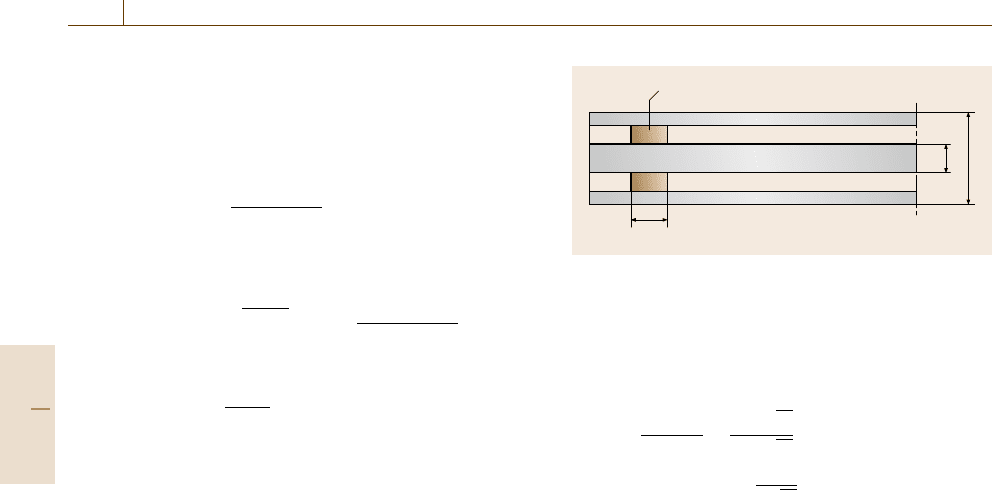
534 Part C Materials Properties Measurement
where, S
11
and S
21
are the measured complex scatter-
ing parameters, γ is the complex propagation constant
(γ = α + jβ), l is the propagation length, and Γ is the
complex reflection coefficient [9.92, 93]. From (9.83)
one can find
e
−γl
=
1 −(S
11
/Γ )
1 −S
11
Γ
1/2
(9.84a)
and then substituting (9.84a)to(9.82) yields 1/2Γ −
1/2Γb +1/2 =0, from which
Γ = b ±
b
2
−1 , b =
S
2
11
−S
2
21
+1
2S
11
(9.84b)
and
Z
s
= Z
0
1 +Γ
1 −Γ
. (9.84c)
In order to determine the values of the complex γ ,
and Z
s
, from (9.84), the measured complex S
11
and S
21
parameters should be returned by the network analyzer
in complex coordinates form i. e. S
ij
=(ReS
ij
, ImS
i
j).
If polar notation is used then the phase angle needs to
be converted to the true value of the measured phase
(β) in radians rather than the cyclically mapped phase
angle ±180
◦
. Results that indicate no physical mean-
ing such as negative attenuation constant (α) need to be
corrected by selecting an appropriate solution of (9.84a)
and (9.84b). Equation (9.84) are general and applicable
to network configurations consisting of a transmission
line with impedance discontinuity Z
0
-Z
s
-Z
0
,whichis
inserted between two reference transmission lines of
the characteristic impedance Z
0
.Onceγ and Zs are
obtained then the circuit distributed parameters, the cor-
responding materials electrical characteristics can be
determined by using the conventional transmission line
relations. The following sections describe application
of (9.84) to measurements of the broadband dielectric
permittivity of bulk materials and thin films.
Two-Port Transmission–Reflection Method
Figure 9.64 shows a testing configuration where the di-
electric specimen of length l partially fills a precision
coaxial air-line of characteristic impedance Z
0
.
The impedance in the specimen section changes
from Z
0
to Z
s
, and thus, this network can be represented
by the flow-graph shown in Fig. 9.64. The scattering
parameters S
11
and S
21
are measured at the reference
planes A and B, and then the complex reflection coeffi-
cient Γ and the propagation constant γ are determined
from (9.84). In the case of nonmagnetic media the di-
electric permittivy ε
∗
r
can be obtained by simultaneously
Specimen
AB
l
ab
Fig. 9.64 Coaxial air-line partially filled with a dielectric
slab of length l. The scattering parameters S
11
and S
21
are
measured at the reference planes A and B, where the line
assumes impedance Z
s
solving (9.85a)and(9.85b)
Γ =
Z
s
−Z
0
Z
s
+Z
0
=
1 −
ε
∗
r
1 +
ε
∗
r
, (9.85a)
γ =
iω
c
ε
∗
r
. (9.85b)
Using an APC-7 precision bead-less coaxial air line
as a sample holder with a = 3.02 mm and b =7.0 mm,
the dielectric permittivity can be measured at frequen-
cies of up to 18 GHz [9.105–107]. However, multiple
wave reflections at the Z
0
-Z
s
-Z
0
interfaces cause inter-
ference that may result in a singular behavior of Z
s
at
certain frequencies.
The dielectric specimen for the transmission-
reflection method described above must be machined
precisely to fit dimensions of the inner (a) and outer
conductors (b) of the coaxial line (Fig. 9.64). A more
detailed description of the measurement and analysis of
this testing procedure can be found in [9.107,108].
One-Port Reflection Method
An important application of network analysis to the
high frequency dielectric metrology is the measurement
of dielectric permittivity of thin films in a short-
terminated coaxial test fixture (Fig. 9.61b).
In order to extend the measurements to the mi-
crowave range, a thin-film capacitance terminating
a coaxial line is treated as a distributed network [9.109].
The wave enters the specimen from the coaxial-air line
of characteristic impedance Z
0
, propagates along the
diameter (a) of the specimen, and returns back to the
coaxial line. The specimen represents a transmission
line of impedance Z
s
and propagation length l,which
corresponds to the diameter of the specimen rather
than to its thickness [9.109]. The wave propagation
and reflection at the Z
0
-Z
s
-Z
0
interfaces can be rep-
Part C 9.5
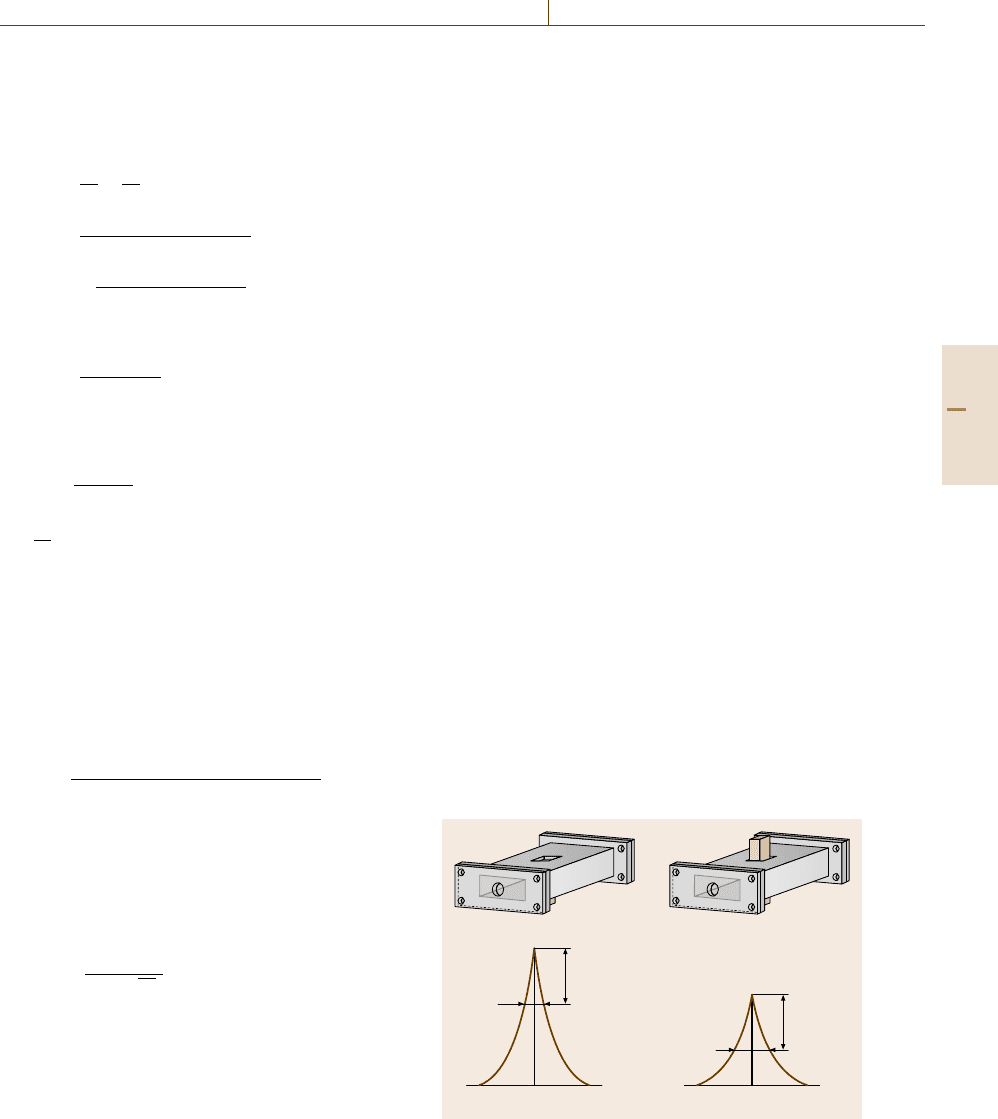
Electrical Properties 9.5 Measurement of Dielectric Materials Properties 535
resented by the flow-graph shown in Fig. 9.63d. Here,
the measured scattering parameter S
11
is a sum of nor-
malized incoming and outgoing waves S
11
= b
1
/a
1
+
b
2
/a
1
, which are given by (9.82)and(9.83) respectively
S
11
=
b
1
a
1
+
b
2
a
1
=
Γ (1− e
−γl
)(1 + e
−γl
)
1 −Γ
2
e
−2γl
+
e
−γl
(1 −Γ )(1+Γ )
1 −Γ
2
e
−2γl
, (9.86)
which simplifies to (9.87)
S
11
=
Γ + e
−γl
1 +Γ e
−γl
. (9.87)
The corresponding expression for the impedance is
given by (9.88)[9.110]
Z
s
=
x cot(x)
iωC
s
+iωL
s
, (9.88)
where, x is the wave propagation parameter x =
ωl
ε
∗
r
/2c, C
s
is the capacitance of the specimen
C
s
=C
0
ε
∗
r
, ω is the angular frequency, l is the propaga-
tion length (l = 2.47 mm in the APC-7 configuration),
and L
s
is the residual inductance of the specimen of
thickness t [9.110]
L
s
=1.27 × 10
7
[H/m]·t [m]. (9.89)
The resulting expression for the relative complex
permittivity ε
∗
r
isgivenby(9.90)
ε
∗
r
=
x cot(x)
iωC
0
(Z
0
1 +S
11
/1−S
11
−iωL
s
)
. (9.90)
Equation (9.90) eliminates the systematic uncer-
tainties of the lumped element approximations [9.97]
and is suitable for high-frequency characterization of
dielectric films of low and high permittivity values.
Equations (9.88)–(9.90) have been validated numeri-
cally and experimentally up to the first cavity resonance
f
cav
=
c
lRe
ε
∗
r
, (9.91)
where Re indicates the real part of complex square root
of permittivity and l = 2.47 mm, which is the propa-
gation length for the APC-7 test fixture presented in
Fig. 9.61b[9.110]. For example, in the case of a spec-
imen with a dielectric constant of 100, f
cav
is about
12 GHz. Since the propagation term x depends on per-
mittivity, (9.90) needs to be solved iteratively. At low
frequencies, where the electrical length of the specimen
is small in comparison to the wavelength, x cot(x) ≈1,
L
s
can be neglected and (9.90) simplifies to the con-
ventional (9.78)and(9.79) for a transmission line
terminated with a lumped shunt capacitance. A de-
tailed description of the measurement procedure and
the calculation algorithm can be found in the refer-
ence [9.111].
Resonant Cavity Methods
Resonant measurement methods are the most accurate
in determining the dielectric permittivity. In order to ex-
cite a resonance the materials must have a low dielectric
loss (ε
r
< 10
−3
). The measurements are usually limited
to the microwave frequency range. A fairly simple and
commonly used resonant method for measurement of
microwave permittivity is the resonant cavity perturba-
tion method [9.112]. Figure 9.65 illustrates a cavity test
fixture which is a short section of rectangular waveg-
uide. Conducting plates bolted or soldered to the end
flanges convert the waveguide into a resonant box.
A small iris hole in each end plate feeds microwave
energy into and out of the cavity. Clearance holes cen-
tered in opposite walls are provided for a dielectric
specimen, which is placed into region of maximum
electric field. The measurement frequency is limited to
few values corresponding to the fundamental mode and
few higher order modes. Typically standard rectangular
waveguide for the X-band [9.106] is used as a test fix-
ture that covers the frequency range from 8 to 12 GHz.
The test specimen may have the shape of a cylindrical
rod, sphere or a rectangular bar [9.112].
The test fixture is connected to a network analyzer
(Fig. 9.62) by using appropriate adapters and waveg-
3dB
3dB
Δf
c
f
c
f
s
Δf
s
a) b)
Fig. 9.65a,b Scattering parameter |S
2l
| measured for
(a) an empty test fixture and (b) for test fixture with a spec-
imen inserted
Part C 9.5
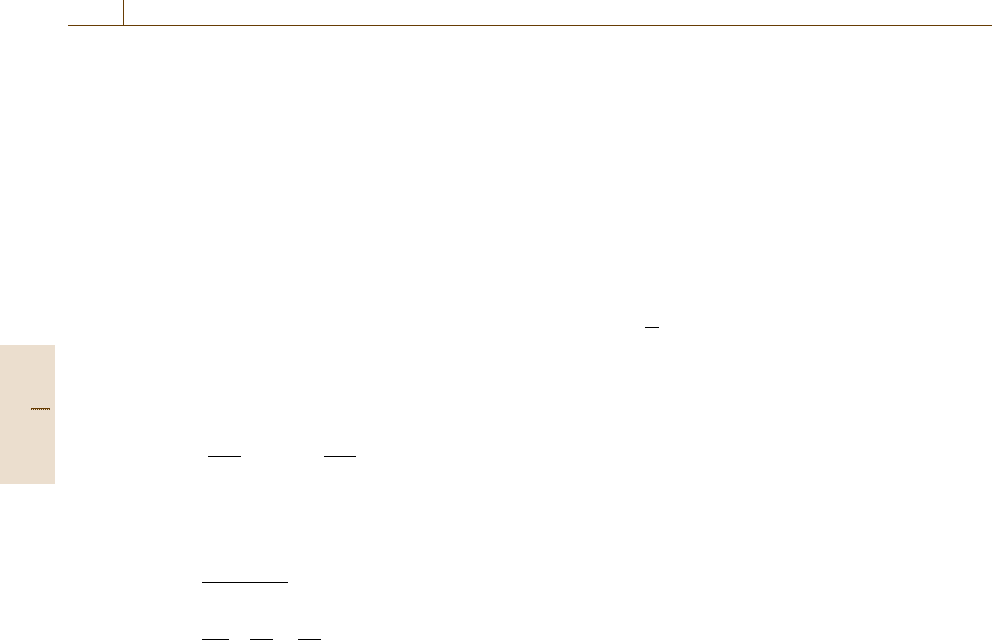
536 Part C Materials Properties Measurement
uides. The resonance is indicated by a sharp increase
in the magnitude of the |S
21
| parameter, with a peak
value at the resonant frequency. When the dielectric
specimen is inserted to the empty (air filled) cavity
the resonant frequency decreases from f
c
to f
s
while
the bandwidth Δ f at half power, i. e. 3 dB below the
|S
21
| peak, increases from Δ f
c
to Δ f
s
(see illustra-
tion in Fig. 9.65). A shift in resonant frequency is
related to the specimen dielectric constant, while the
larger bandwidth corresponds to a smaller quality fac-
tor Q, due to dielectric loss. The cavity perturbation
method involves measurement of f
c
, Δ f
c
, f
s
, Δ f
s
,and
volume of the empty cavity V
c
and the specimen vol-
ume V
s
.
The quality factor for the empty cavity and for the
cavity filled with the specimen is given by (9.92)
Q
c
=
f
c
Δ f
c
, Q
s
=
f
s
Δ f
s
. (9.92)
The real and imaginary parts of the dielectric constant
are given by (9.93)and(9.94), respectively
ε
r
=
V
c
( f
c
− f
s
)
2V
s
f
s
, (9.93)
ε
r
=
V
c
4V
s
1
Q
s
−
1
Q
c
. (9.94)
The resonant cavity perturbation method described
above requires that the specimen volume be small com-
pared to the volume of the whole cavity (V
s
< 0.1V
c
),
which can lead to decreasing accuracy. Also, the spec-
imen must be positioned symmetrically in the region
of maximum electric field. However, compared to other
resonant test methods, the resonant cavity perturbation
method has several advantages such as overall good ac-
curacy, simple calculations and test specimens that are
easy to shape. Moreover, circular rods, rectangular bars
or spheres are the basic designs that have been widely
used in manufacturing ceramics, ferrites and organic
insulting materials for application in the microwave
communication and electric power distribution.
There is a large number of other resonant techniques
described in the technical and standard literature, each
having a niche in the specific frequency band, field
behavior and loss characteristic of materials. Some of
these are briefly described below.
Sheet low loss materials can be measured at X-band
frequencies by using a split cavity resonator [9.113].
The material is placed between the two sections of
the splitable resonator. When the resonant mode is ex-
cited the electric field is oriented parallel to the sample
plane.
The split-post dielectric resonator technique [9.114]
is also suitable for sheet materials. The system is excited
in the transfer electromagnetic azimuthal mode. A use-
ful feature of this type of resonant cavity is the ability
to operate at lower frequencies without the necessity of
using use large specimens.
Parallel-plate resonators [9.115] with conducting
surfaces allow measurements at lower frequencies since
the guided wavelength λ
g
inside the dielectric is smaller
than in the air-filled cavities by a factor of approxi-
mately
ε
r
. The full-sheet resonance technique [9.116]
is commonly used to determine the permittivity of cop-
per clad laminates for printed circuit boards.
9.5.4 Uncertainty Considerations
With increasing frequency, the complexity of the di-
electric measurement increases considerably. Several
uncertainty factors such as instrumentation, dimen-
sional uncertainty of the test specimen geometry,
roughness and conductivity of the conduction surfaces
contribute to the combined uncertainty of the measure-
ments. The complexity of modeling these factors is
considerably higher within the frequency range of the
LC resonance. Adequate analysis can be performed,
however, by using the partial derivative technique [9.97,
107] and considering the instrumentation and the di-
mensional errors. Typically, the standard uncertainty
of S
11
can be assumed to be within the manufac-
turer’s specification for the network analyzer, about
±0.005 dB for the magnitude and ±0.5
◦
for the phase.
The combined relative standard uncertainty in geo-
metrical capacitance measurements is typically smaller
than 5%, where the largest contributing factor is the
uncertainty in the film thickness measurements. Equa-
tion (9.90), for example, allows evaluation of systematic
uncertainty due to residual inductance. It has been val-
idated empirically for specimens 8–300 μm thick for
measurements in the frequency range of 100 MHz to
12 GHz. These are reproducible with relative combined
uncertainty in ε
r
and ε
r
of better than 8% for spec-
imens having ε
r
< 80 and thickness t < 300 μm. The
resolution in the dielectric loss tangent measurements
is < 0.005. Additional limitations may arise from the
systematic uncertainty of the particular instrumentation,
calibration standards and the dimensional imperfections
of the implemented test fixture [9.106]. Furthermore,
the results of impedance measurements may not be reli-
able at frequencies, where |Z| decreases below 0.05 Ω.
Part C 9.5
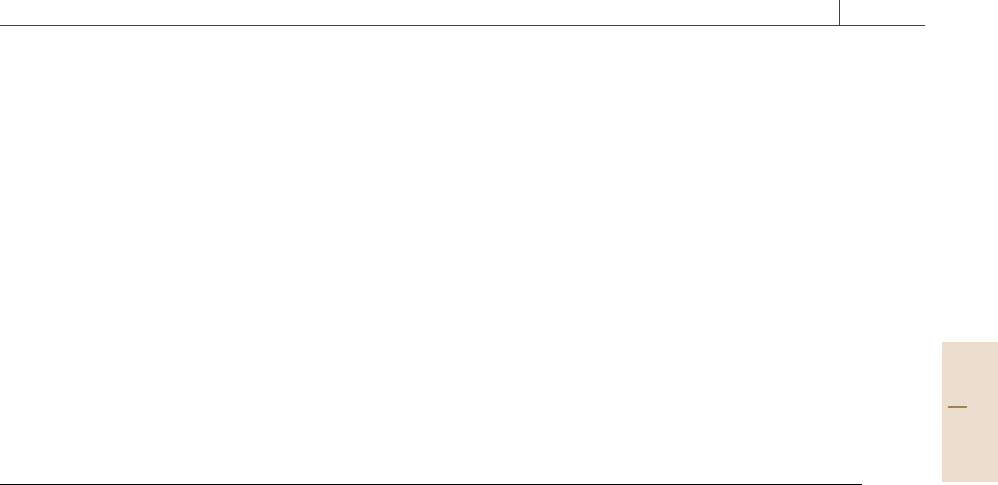
Electrical Properties References 537
9.5.5 Conclusion
In summary, one technique alone is typically not suffi-
cient to characterize dielectric materials over the entire
frequency range of interest. The lumped parameter ap-
proximate equations (9.72)–(9.76) can be utilized when
they yield the required accuracy. The upper frequency
limit for lumped parameter techniques is typically in the
range of 100–300 MHz. Precision coaxial test fixtures
can extend the applicability of the lumped parame-
ter measurement techniques into the microwave range
(9.78)–(9.79). When the effective values of circuit
elements change with frequency due to wave propa-
gation effects, it is necessary to use the distributed
circuit analysis (9.84) along with the correspond-
ing microwave network measurement methodology.
The microwave broad-band one-port reflection method
(9.88)–(9.90) is most suitable for thin high dielec-
tic constant films that are of interest to electronics,
bio- and nano-technologies. For bulk anisotropic di-
electics, the microwave two-port transmission reflection
method (9.85) is probably the most accurate broad-band
measurement technique. The resonant cavity method
(9.92)–(9.94) is best for evaluating low-loss solid di-
electric materials that have the standard shapes used in
manufacturing ceramics, ferrites, and organic insulting
materials for application in microwave communication
and electric power distribution.
In order to avoid systematic errors and obtain the
most accurate results, it is important that the proper
method is used for the situation at hand. Therefore mea-
surements of dielectric substrates, films, circuit board
materials, ceramics or ferrites always present a metro-
logical challenge.
References
9.1 R.E. Hummel: Electrical properties of materials. In:
Understanding Materials Science,ed.byR.E.Hum-
mel (Springer, New York, Berlin 2004) pp. 185–222,
Chap. 11
9.2 C.H. He, Z. Lu, S. Liu, R. Liu: Cross-conductivity stan-
dard for nonferrous metals, IEEE Trans. Instrum.
Meas. 44, 181–183 (1995)
9.3 G. Rietveld, C.V. Koijmans, L.C.A. Henderson,
M.J. Hall, S. Harmon, P. Warnecke, B. Schumacher:
DC conductivity measurements in the van der Pauw
geometry, IEEE Trans. Instrum. Meas. 52, 449–453
(2003)
9.4 L.J. van der Pauw: A method of measuring specific
resistivity and Hall effect of discs of arbitrary shape,
Philips Res. Rep. 13,1–9(1958)
9.5 DIN IEC 468: Method of Measurement of Resistivity of
Metallic Materials (Beuth, Berlin 1981)
9.6 NPL Report DEM-ES 001: Techniques and materials for
the measurement of DC and AC conductivity of non-
ferrous metals and alloys, Conductivity, May 2004,
the Conductivity project is (has been) financially
supported by an EU grant (contract No. G6RD-CT-
2000-00210) under the EU Growth programme, part
of the 5th Framework programme
9.7 M.J. Hall, L.C.A. Henderson, G. Ashcroft, S. Harmon,
P. Warnecke, B. Schumacher, G. Rietveld: Discrep-
ancies between the DC and AC measurement of low
frequency electrical conductivity, Dig. Conf. Proc.
Electrom. Meas. CPEM 2004, London (2004) pp. 34–35
9.8 A.C. Lynch, A.E. Drake, C.H. Dix: Measurement of
eddy-current conductivity, IEE Proc. Sci. Meas. Tech-
nol. 130,254–260(1983)
9.9 H. Kamerlingh Onnes: The superconductivity of mer-
cury, Commun. Phys. Lab. Univ. Leiden 122b,13–15
(1911)
9.10 J. Bardeen, L.N. Cooper, J.R. Schrieffer: Theory of
superconductivity, Phys. Rev. 108, 1175–1204 (1957)
9.11 J.G. Bednorz, K.A. Müller: Possible high-T
c
super-
conductivity in the Ba-La-Cu-O system, Z. Phys. B
64, 189–193 (1986)
9.12 M.K. Wu, J.R. Ashburn, C.J. Torng, P.H. Hor,
L.R. Meng, L. Gao, Z.J. Huang, Y.Q. Wang, C.W. Chu:
Superconductivity in a new mixed phase Y-Ba-Cu-
O system at ambient pressure, Phys. Rev. Lett. 58,
908–910 (1987)
9.13 C.N.R. Rao, R. Nagarajan, R. Vijayaraghavan: Syn-
thesis of cuprate superconductors, Supercond. Sci.
Technol. 6, 1–22 (1993)
9.14 J. Clarke, A.I. Braginski: The SQUID Handbook, Fun-
damentals and Technology of SQUIDs and SQUID
Systems, Vol. 1 (Wiley, New York 2004)
9.15 B.D. Josephson: Possible new effects in supercon-
ductive tunneling, Phys. Lett. 1, 251–253 (1962)
9.16 R. Pöpel: The Josephson effect and voltage stan-
dards, Metrologia 29, 153–174 (1992)
9.17 W. Meissner, R. Ochsenfeld: Ein neuer Effekt bei Ein-
tritt der Supraleitfähigkeit, Naturwissenschaften 21,
787 (1933), (in German)
9.18 S.A. Keys, D.P. Hampshire: Characterization of
the transport critical current density for conduc-
tor applications. In: Handbook of Superconducting
Materials. II: Characterization, Applications and
Cryogenics, ed. by D.A. Cardwell, D.S. Ginley (IOPP,
London 2003) p. 1297
9.19 DIN EN IEC 61788-1: Superconductivity – Criti-
cal, Current Measurement – DC Critical Current of
Cu/Nb-Ti Composite Superconductors (Beuth, Berlin
1999)
9.20 P.W. Atkins: Physikalische Chemie, 3rd edn. (VCH,
Weinheim 1990) pp. 3834–3846, (German transl.)
Part C 9
